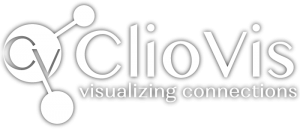Written by: Aidan Dresang, ClioVis Intern and University of Texas History Major
July 31, 2024.
The current state of student-engagement in the classroom
On my first day of 11th-grade history, I remember the sense of gloom I felt when I was presented with a nearly 500-page history textbook. The textbook seemed to suggest that the history of the United States could be summed up in a single, linear, narrative devoid of connections and nuance. This was no fault of my wonderful teacher — I still reflect on her amazing lessons. Rather, it is partly a symptom of the lack of accessible and easy methods teachers have at their disposal to get students to make connections between different historical events.
My perspective
As a student studying to become a public high school history teacher, I often think about how I can best engage students with history and encourage them to find connections between different historical events. How can I find creative timeline project ideas for history classes?
How can digital tools help?
ClioVis, a technology I first used in college in Dr. Erika Bsumek’s course, offers a new way for students to immerse themselves in history. The software allows students to visualize history on a timeline, make connections between events, incorporate multimedia to build an argument and present their projects when finished. Since I really liked the project I created with the technology, I wanted to share my ideas about how it and other technologies could potentially be used to create similar products.
Video walkthrough
Visually breaking down history
Teaching history to a diverse set of learners can be hard. The traditional method of presenting while students take notes is becoming increasingly less popular as research shows that students need various ways to engage with material to maximize their learning. ClioVis allows students to visually break down complex history onto an interactive timeline. Students can map out different events while categorizing them and placing them into different ‘eras.’ Now, instead of (or in addition to) making concept maps on a whiteboard, you can allow students to take their ideas online.
Connecting events (concept mapping)
One of the greatest features of timeline technology is that it allows students to connect different events and concepts simply by drawing an arrow or line. Students are then prompted to explain the connection between the events. As teachers struggle to combat AI, ClioVis’s connection feature highlights Human Intelligence (HI). This feature encourages students to analyze the ways different historical concepts and events interact.
Incorporating multimedia and digital literacy
Allowing students to interact with multimedia (historical and contemporary) is immensely important for student comprehension and engagement. ClioVis allows students to attach images, audio files, and even videos onto individual event nodes. The possibilities are endless—you may have students navigate online historical archives for videos, create their TikTok to expand on a historical event, or practice their digital literacy skills by finding a reputable YouTube video. Whatever you choose, there are benefits of using a visual storytelling tool in education.
Reciprocal teaching
Imagine you have students break up into groups and create timelines on different subjects you are covering in class (conveniently using the real-time collaborative feature, of course). Now, with the timelines finished, you want students to share their work with each other. ClioVis enables students to easily share their timelines with each other through the “present” feature. The feature allows a presenter to navigate through the timeline almost like a powerpoint, easily sharing their work.
Conclusion
Having already taught in several high school history classrooms I see the need for a technology that allows students to draw connections between various events. Digital tools can fill that need and offer a new, engaging way for students to think and learn about history.
